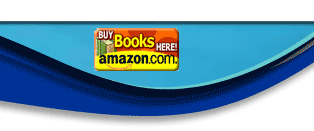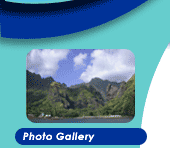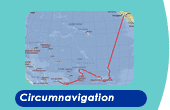Up the Creek
Down the Creek
Letter from Gove
Mackay's Boatyard
The Night of the Cane Toad Queen
Why Gamble on Cane Toads?
MacKay to Cairns Australia
100 Magic Miles, Great Barrier Reef
16 55. 038S
145 46. 9028E
Not knowing at the time this would later be called "showering with the sharks,"
we dove in the water to swim around the boat for exercise........
By Ret Ekdahl
It was a dream come true! My husband of 31 years and I stepped off the tilt train into the arms of my sister and her husband Gunter, who had been patiently waiting for our arrival. It was exciting enough that we had not been away from our children in 25 years, but to actually be in MacKay , Australia , about to sail 400 miles of the Great Barrier Reef , was – well - just intoxicating. Anticipation had finally become reality!
We had seen and heard so much about their boat Pacific Bliss we felt like we already knew her. We boarded her with reverence, slipping our shoes off before climbing the ladder and getting the tour. Our sleeping cabin and bathroom were opposite the boat hull from my sister's. We were shown how to “flush” the toilet by manually pumping - the rule on this boat is “nothing goes in the water that doesn't come out of the body” which was just a reminder not to flush the paper. Hmmmm.
I was still pondering that this seemed a bit much like camping (which I severely disliked) when my husband whispered to me “Ret, I think we have a problem. I don't think I can fit in there!”
John, being the tall large man that he is, may not have been exaggerating in his worries. I was a little concerned about myself, in fact. We stared at the small, intimate white hole with less than a cup of water in it a moment longer, then I whispered back, “I think if we back in it might work, but there is no room for magazines…”
We awoke the next morning to the aroma of fresh coffee, the sound of waves lapping the hull (our new room), and a beautiful sunrise. Wasn't it just GREAT to be alive!! I was so eager for our first sail to begin! We were briefed on our duties for departure, held hands, and offered a prayer to our Maker for the safety of Voyage 5. It was tradition to play “Amazing Grace” at the beginning of each voyage, so as I “battened down the hatches”, chill bumps raced up and down my spine while its lyrics floated in the air around us. Ropes were securely looped and tied, fenders stowed away in proper lockers, and we were on our way. I went down below to grab my sunglasses and camera.
When I came back up, Lois was sitting at one helm and Gunter at the other, legs stretched out on the benches, both reading a section of the newspaper. I glanced around to see John relaxed on the trampoline. Panicked, I said, “Who's driving this boat?”
Lois and Gunter looked at each other, then back at me. “Ray, of course,” Lois said lowering her newspaper a little.
“Ray?” I said, confused. “I don't remember any Ray…”
Lois calmly folded her newspaper, handed it to Gunter, saying, “I'll introduce her to Ray. Come on, Sis.”
She took me to the navigation station where a computer named Raytheon was showing us the course we were on. “We call him Ray,” she said, “he's a very important part of our crew. Of course, we have backup plans, but he is our number one man.”
I watched as she showed how to chart a course, set way points (points on the map, longitude and latitude, where they would make the next turn) and how to stay on course. The jargon became increasingly technical.
I sheepishly reminded her, “Remember, I'm the one who can't set my VCR clock?”
She said, “Ret, even you can do this. The blue line is your plotted course. You want the red line, your current course, to follow it. Pressing this plus or minus button will alter your course by degrees – here, you do it.”
“You're kidding, right?” I said. “It can't be that simple. You mean we don't have to take turns at the wheel?”
“Nope” she said, as I pressed the minus button to turn our boat a few more degrees to the right.
“Perfect”, she said, and checked the estimated time until the next waypoint and turn. “We have 7 minutes until our next turn. Let's go back outside.”
This was my crash course on navigation. Later I would learn how to compare the computer screen to our large maps spread out on the table looking for any obstacles, markers, or buoys. For now, this was enough to digest.
Then the skies grew dark and foreboding. The winds were picking up strength. Lois and Gunter exchanged a few fearful looks at each other as the gusts seemed increasingly more powerful.
“That was an F-7 gust,” Lois shouted to Gunter who had gone inside to listen to the Volunteer Marine Frequency for a weather update.
Enjoying the speed at which we were sailing, I glanced at my husband to see if he was taking the motion okay. He had spent 5 seasick years in the Navy, and had never forgotten it.
“Time to put on the gadget?” I said, as he passed me on his way down below.
“Seas are getting a bit lumpy”, he said, confirming my suspicion.
We had invested in various seasickness cures. The patch had already been discarded because the cure was worse than the cause. Our next tact would be the electronic “watch” that prevents the “I think I'm going to be sick” messages from getting to the brain. (It proved to be miraculous for our three week sail.)
We heard a patchy message coming over the radio sounding like a boat in trouble, but couldn't quite make out the transmission. I was still enjoying the ride, when I heard Gunter say to his navigator, “Do you think we should turn back?”
She checked the charts and computer screen. “No, I think we're better off riding it out. We should be out of it soon.”
Gunter turned to us and said, “I'm so sorry. Are you okay?”
“Okay?” I thought. “Why wouldn't we be okay? The sails aren't even up, yet we are flying over these huge waves, and it's all wonderful! How much better does it get?!!”
Then suddenly the gauge Gunter was watching registered F9. “Lois!” he shouted. “It's F9!!”
She ran from her navigation station inside to look at the same gauge outside. “I can't believe it”, she said. “The forecast said possible isolated showers - nothing about F9 squalls.”
And then we all heard the radio transmission loud and clear. “VMR, VMR. (Volunteer Marine Rescue) MAY DAY. MAY DAY. This is Wanderbird II. We have gone aground, we are abandoning ship. Repeat, abandoning ship.”
Okay, NOW I was concerned. It's an old cliché, but we felt their pain. It was a nasty day at sea, and this same boat had been our neighbor at the McKay Marina. We recognized the name. Our ears were tuned to the radio, our eyes peeled to the sky and navigation station, as the perpetual smile I'd had since arriving in Australia slid from my face.
But the squall left almost as soon as it had appeared. According to the captain's log book, the storm lasted exactly one hour and 10 minutes. I learned the worst storm they had ever been in was off the coast of Columbia . That storm held sustained force 10 winds for three days. Force 12 is as high as it gets. We had just experienced Force 9!
We sailed for several more hours into beautiful skies and calm seas to our first anchorage just off the coast of Goldsmith Island . We were coached on how to assist in the process of dropping anchor. The perpetual smile returned to my face as we prepared our lunch, and it remained for the next three weeks. Life was still great!!
We chose not to go ashore in the dinghy, but to stay on board, relax, enjoy good conversation and a game of Scrabble. Before long, we watched our first sunset at sea. Every five minutes the sky would change to another spectacular photo op until the sun totally set on the horizon.
“Why had I never experienced the joy of a sunset before now?” I asked myself. It was a moment in time I will never forget, and one we were to experience each night of our trip.
We arrived at Hamilton Island , the renowned resort island, the next day around 1 pm. Holding a slip in the marina gave us use of all the island amenities. And they were plentiful! The luxurious pool, set right on the ocean, had a swim up bar and live jazz band music. We felt like we had landed in paradise. “So this is how the rich people live!” I said, as we settled in for the day.
Nearing sunset, we rode our rental golf cart to the top of Hamilton Island to watch the sunset. What a treat to find a bar set up with wine, crackers, and cheese. As the live jazz band began playing to the gathering crowd, we took photos in five minute increments of the setting sun, each photo different from the other. The glowing orange was shadowed by mountains, palms, and finally the blue water of the bay. This was a moment of bliss. It can't possibly get any better than this!!
Upon leaving Hamilton Island , we enjoyed two more days of sunshine and calm seas. Our first night was spent anchored at Nara Inlet just past Refuge Bay , breeding grounds for tiger and hammerhead sharks. I watched my first “feeding frenzy” here, now understanding where the term comes from. The water was churning with the big fish trying to catch the little fish. I also saw my first “overfalls” here – created by the tide and currents. We were surrounded by mountains on three sides which made for yet another picturesque sunset.
The second night we moored at Butterfly Bay , preparing for our first “overnight” sail. We sailed all night, taking turns with three hour watches. Since we didn't want to miss another sunset, Lois and I took the first watch from 6 pm to 9 pm. We were sailing in the freighter shipping lane, so we really did need to pay attention. The full moon was brilliantly lighting our path, and I had “forced” one on one time with my sister for three hour stretches. “Does it get any better than this?” I again ask myself!
We sailed our scheduled 150 miles, seeing only nine freighters in all, the only drama being in our gossip sessions and the possible overdosing of chocolate. We arrived at Magnetic Island exactly 24 hours from departure from Butterfly Bay , at 9:40 am.
Since it had been several days without showers, Lois and Gunter showed us how to shower from the swim steps of Pacific Bliss. Not knowing at the time this would later be called “showering with the sharks,” we dove in the water to swim around the boat for exercise first. Coming back to the swim steps, we “showered” with soap, rinsing off first in the ocean and then with the fresh water hose.
Later, feeling totally refreshed, we lowered the dinghy into the water and motored to shore. While Lois, John and I were checking out the island, Gunter read his newspaper near the beach. Striking up a conversation with the lifeguard, Gunter asked, “The sign says to beware of jellyfish – that season is over though isn't it?”
“No,” the lifeguard replied.” You shouldn't swim in these waters,” he said. “Box jellyfish are still in season, and there are both tiger and hammerhead sharks in this bay, AND there are crocodiles.” He pointed out the shark net that surrounded the swim area. “You should only swim in protected areas like this.”
That was the last time I swam from the boat during our trip!
We leisurely sailed northward for another five days, usually anchored by mid afternoon in a new bay or marina. Orpheus Island , the Hitchinbrook Marina, Dunk Island , and Fitzroy Island were all magnificent. The great conversations just multiplied. Who says sailors have a lonely life? The sailor stories just kept getting better! And so did the food. After two weeks of watching my sister cook gourmet meals onboard, I finally said, “Okay, who are you and what have you done with my sister?” Cruisers exchange recipes, I discovered, and they were ALL good!
When I saw the city of Cairnes on the distant horizon my eyes filled with tears. Even though we had another week at the marina before flying back to Texas , it would be the end of our wonderful sailing adventure. We knew the only way we could say goodbye to the sunsets, Pacific Bliss, and crew was to NOT say goodbye, but to quote Arnold , “I'LL BE BACK!” And so we will.
|
|
 |
 |
 |
|
|||||||||
|
|
|
||||||||||||
|
|
|
||||||||||||
|
|
|
||||||||||||
|
|
|
|
|
|
|
|
|
|
|||||
|
|
|
||||||||||||
|
|
|
||||||||||||
 |
 |
|
|||||||||||
|
|
|
||||||||||||
|
|
|
||||||||||||
|
|
|
||||||||||||
 |
|
||||||||||||
|
|
|
||||||||||||
|
|
|
||||||||||||
 |
|
||||||||||||
 |
|
||||||||||||
 |
|
||||||||||||
 |
|
||||||||||||
 |
|
||||||||||||
|
|
|
|
|
|
|
|
|
|
|
|
|
|
|
